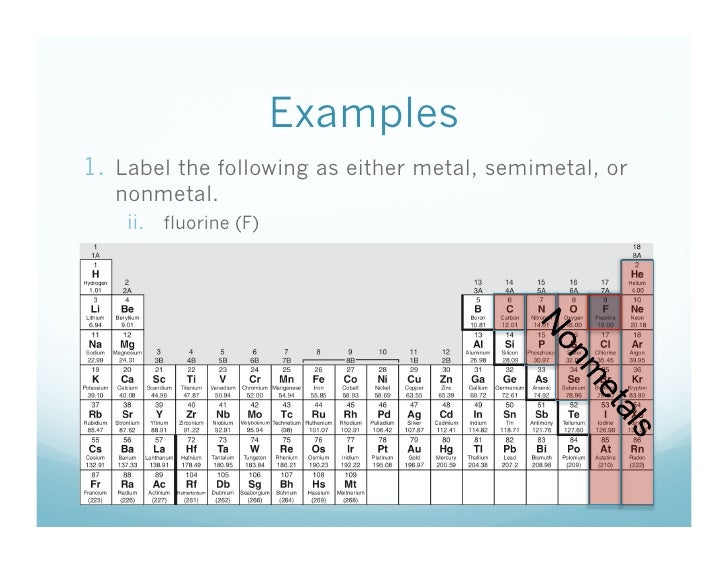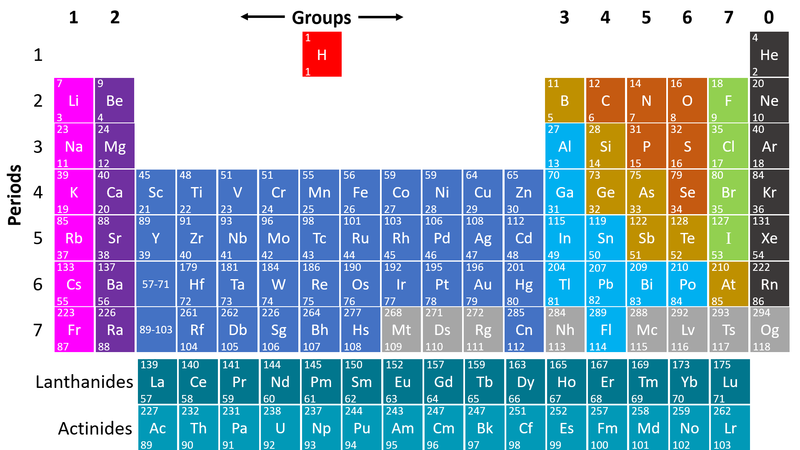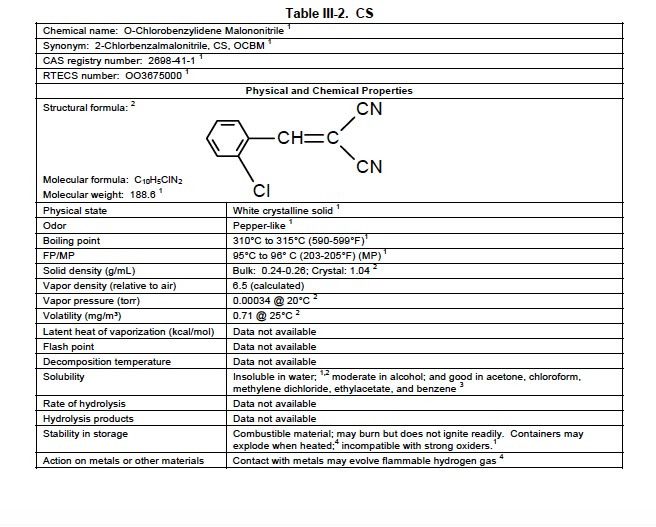45 periodic table with metal and nonmetal labels
Metals and Non Metals of the Periodic Table From Group 13 to 16 these are a mixture of metals, non-metals, and semimetals. For example Group 15 contains the non-metals Nitrogen and Phosphorus, the semi-metal Arsenic and the metals Antimony and Bismuth. These non metals have very different properties to metals, they do not tend to barde shiny and wont conduct heat or electricity well. Periodic table labeled with Metals Nonmetals and Metalloids Periodic table labeled with Metalloids Above picture shows you the labeled Metalloids on the Periodic table. They are found between the metals and nonmetals. Elements which have the metallic properties as well as nonmetallic properties are classified as Metalloids. Because of this reason, they are also known as semimetals.
On Periodic Table Label Alkaline Earth Metals Halogens 1 number of the routine kitchen table that is not going to should be in the steel family is the halogens. These extremely reactive no-metal components are found in class 17 and make up the 17th column. They can be made up of fluorine, chlorine and bromine and iodine, so that as of this composing, astatine.
Periodic table with metal and nonmetal labels
Periodic Table: Metals, Non-metals, and Metalloids - Quizlet Terms in this set (40) Metalloid. the set of elements that separate the metals from the nonmetals on the periodic table and that possess properties of both metals and nonmetals. Period. Group. Periodic trend (This is why the table is called periodic) These groups are entirely metals. This group is entirely inert (non-reactive gases) opengeology.org › textbook › 3-minerals3 Minerals – An Introduction to Geology Derive basic atomic information from the Periodic Table of Elements. Describe chemical bonding related to minerals. Describe the main ways minerals form. Describe the silicon-oxygen tetrahedron and how it forms common silicate minerals. List common non-silicate minerals in oxide, sulfide, sulfate, and carbonate groups. codes.iccsafe.org › content › IRC20182018 INTERNATIONAL RESIDENTIAL CODE (IRC) - ICC User note: About this chapter: The purpose of Chapter 11 [RE] is to provide minimum design requirements that will promote efficient utilization of energy in buildings. The requirements are directed toward the design of building envelopes with adequate thermal resistance and low air leakage, and toward the design and selection of mechanical, water heating, electrical and illumination systems ...
Periodic table with metal and nonmetal labels. Nonmetal - Wikipedia In periodic table terms, an analogy can be drawn between the noble gases and noble metals such as platinum and gold, with the latter being similarly reluctant to enter into chemical combination. As a further example, xenon, in the +8 oxidation state, forms a pale yellow explosive oxide, XeO 4 , while osmium , another noble metal, forms a yellow strongly oxidizing oxide, … Chapter 11 [RE] Energy Efficiency - UpCodes Where the total building thermal envelope UA, the sum of U-factor times assembly area, is less than or equal to the Total UA resulting from multiplying the U-factors in Table N1102.1.4 by the same assembly area as in the proposed building, the building shall be considered to be in compliance with Table N1102.1.2. Periodic Table of the Elements - Metals The elements are divided into two main types, metals and nonmetals, based on their properties. About 75% of the elements are classified as metals. The name metal comes from the Greek word "m tallon" meaning "mine, quarry, metal". Properties of metals: Mostly solids Hard, shiny, malleable meaning flexible Blocks of the Periodic Table: s-block, p-block, d-block, f-block Also, read about Trends in Periodic Table, here. Non - Metals Non-metals are located at the top right-hand side of the Periodic Table. In a horizontal row, the property of elements changes from metallic on the left to non-metallic on the right. Non-metals are usually solids or gases at room temperature with low melting and boiling points.
Build an Atom - Atoms | Atomic Structure | Isotope Symbols - PhET Build an atom out of protons, neutrons, and electrons, and see how the element, charge, and mass change. Then play a game to test your ideas! The Periodic Table: Metals, Nonmetals, and Metalloids Using the periodic table, you can classify the elements in many ways. One useful way is by metals, nonmetals, and metalloids. The periodic table is organized in families and periods . Metals In the periodic table, you can see a stair-stepped line starting at Boron (B), atomic number 5, and going all the way down to Polonium (Po), atomic number 84. (PDF) general-chemistry.pdf | Sumit Banerjee - Academia.edu general-chemistry.pdf Different Types of Metals on the Periodic table (With Image) There are total 17 Rare Earth metals on the Periodic table. Rare Earth Metals includes all the 15 Lanthanides as well as scandium (Sc) and yttrium (Y). So total 15 + 2 = 17 Rare Earth metals. If you are thinking that rare earth metals are those types of metals on Periodic table which are very rarely available, then you are WRONG.
Elements and The Periodic Table | CHEM 1305 Introductory Chemistry ... Using the periodic table, classify each of the following elements as a metal or a nonmetal, and then further classify each as a main-group (representative) element, transition metal, or inner transition metal: cobalt europium iodine indium lithium oxygen cadmium terbium rhenium Show Answer Identifying Elements Carbon-based SERS biosensor: from substrate design to … 22.1.2021 · Metal enclosure refers to transition metal enclosure, such as Pt, Pd, and Ru. Nonmetal shells refer to the silica shell, Al 2 O 3 shell, TiO 2 shell, graphene shell, carbon (C) shell, and other ... Periodic Table of Elements: Los Alamos National Laboratory Metalloid (or "semi-metal" or "poor metal"). The metalloids are B, Si, Ge, As, Sb, Te, and Po. They sometimes behave as semiconductors (B, Si, Ge) rather than as conductors. Lanthanides. The lanthanides comprise elements 57 (lanthanum, hence the name of the set) through 71. They are grouped together because they have similar chemical properties. Metals and non-metals in the periodic table - PubMed A link between that theory and the work of Sir Nevill Mott on the metal-non-metal transition is also highlighted. The application of the 'simple', but highly effective Goldhammer-Herzfeld and Mott criteria, reveal when a chemical element of the periodic table will behave as a metal, and when it will behave as a non-metal.
Labeled Periodic Table of Elements with Names - Science Struck Non-Metals: Hydrogen, Carbon, Nitrogen, Oxygen, Phosphorus, Sulfur and Selenium are seven non-metals located in the 14th, 15th and 16th group of the periodic table. These elements are very brittle and do not easily conduct electricity. Noble Gases: Noble gases are located in 18th group of the periodic table. Helium, Neon, Argon, Krypton, Xenon ...
Metals, Non-Metals and Metalloids - GeeksforGeeks Metals, non-metals, and metalloids are the most common elements. Compounds, on the other hand, are pure entities formed by the chemical combination of two or more elements in a predetermined ratio. Chemical procedures, on the other hand, can break down these compounds into individual elements. e.g. gold, copper, oxygen, chlorine, diamond, etc.
Metals and non-metals in the periodic table - The periodic table - AQA ... Metals are on the left of the periodic table, and non-metals are on the right. Atomic structure and the periodic table Elements in group 1 and group 2 are metals. Atoms of group 1 elements have one...
Periodic table metals metalloids and nonmetals 10000+ results for 'periodic table metals metalloids and nonmetals' Metals, Metalloids and Nonmetals Gameshow quiz by Ktsimms31 G5 Science 6.6A Metals, Nonmetals and Metalloids Group sort by Jmonarez G6 G8 Metals, Nonmetals, Metalloids Maze chase by Kelsiedreiling2 G6 Science Metals Nonmetals and Metalloids Match up by Kmarchetti
1910.1450 App A - Occupational Safety and Health Administration The CSB issued a case study on an explosion at Texas Tech University in Lubbock, Texas, which severely injured a graduate student handling a high-energy metal compound. Since 2001, the CSB has gathered preliminary information on 120 different university laboratory incidents that resulted in 87 evacuations, 96 injuries, and three deaths.
phet.colorado.edu › en › simulationBuild an Atom - Atoms | Atomic Structure | Isotope Symbols ... Build an atom out of protons, neutrons, and electrons, and see how the element, charge, and mass change. Then play a game to test your ideas!
ADprofumeria - Acquista Profumi Tester 100% Originali Periodic table packet 2 answer sheet Anima Wood-U. INFORMATION ON THE ... 2022 · Periodic trends worksheet 2 answers. 10. __ is the only liquid nonmetal. . Prepare the chemistry if8766 ... 3d104s 24p b. Whats people lookup in this blog: Jan 29, 2022 · Notice the location of the labels: s block: first 2 columns on the left hand side of ...
3 Minerals – An Introduction to Geology 3.2 Formation of Minerals. Minerals form when atoms bond together in a crystalline arrangement. Three main ways this occurs in nature are: 1) precipitation directly from an aqueous (water) solution with a temperature change, 2) crystallization from a magma with a temperature change, and 3) biological precipitation by the action of organisms.. 3.2.1 Precipitation from aqueous …
Metals, Nonmetals, and Metalloids of the Periodic Table - ThoughtCo Elements of the periodic table are grouped as metals, metalloids or semimetals, and nonmetals. The metalloids separate the metals and nonmetals on a periodic table. Also, many periodic tables have a stair-step line on the table identifying the element groups. The line begins at boron (B) and extends down to polonium (Po).
Labeled Periodic Table | Science Trends Semimetals, or metalloids, have properties which are in between metals and nonmetals. These properties are: Can be either dull or shiny Often effective semiconductors Can lose or gain electrons in chemical reactions Have several different forms Nonmetals are elements that have properties which are quite distinct from metals.
Periodic Table/Metals/Nonmetals Quiz - Quizizz D. Question 10. 30 seconds. Q. A student tested the conductivity of four elements using an incomplete electrical circuit. When the element is placed in the circuit, the bulb lights up brightly, lights up dimly, or does not light up at all based on the element's ability to conduct electricity. The table below shows the results of her ...
en.wikipedia.org › wiki › NonmetalNonmetal - Wikipedia In periodic table terms, an analogy can be drawn between the noble gases and noble metals such as platinum and gold, with the latter being similarly reluctant to enter into chemical combination. As a further example, xenon, in the +8 oxidation state, forms a pale yellow explosive oxide, XeO 4 , while osmium , another noble metal, forms a yellow ...
Metal and non-metal oxides - The periodic table - BBC Bitesize Metals are on the left of the periodic table, and non-metals are on the right Oxides are substances made of two or more types of chemically bonded together. All are compounds, and contain a single...
Metalloid - Wikipedia Periodic table extract showing groups 1–2 and 12–18, ... Elements bordering the metal–nonmetal dividing line are not always classified as metalloids, ... labels aluminium as a weak metal. It has the physical properties of a metal …
Labeled Periodic Table of Elements with Name [PDF & PNG] There are 18 groups in the periodic table, which consists of metal and nonmetal. Protons in the tables are positively charged particles. Neutrons are the neutrally negative charge, and electrons are the negative charge particles. It also shows the formation of a bond from one element to the other. PDF Labelled Periodic Table with Charges

Draw a part of the long form of periodic table showing a non metal surrounded by non metals from ...
› 37409050 › general_chemistry_pdf(PDF) general-chemistry.pdf | Sumit Banerjee - Academia.edu general-chemistry.pdf
en.wikipedia.org › wiki › MetalloidMetalloid - Wikipedia Recognition status, as metalloids, of some elements in the p-block of the periodic table. Percentages are median appearance frequencies in the lists of metalloids. The staircase-shaped line is a typical example of the arbitrary metal–nonmetal dividing line found on some periodic tables.







![QTR [Brainiac: Science Abuse]](https://blogger.googleusercontent.com/img/b/R29vZ2xl/AVvXsEjlQjg0AZrRr3k5jopZ0Xm2PYz-0jQDE_PS6Ta-BvMzT0YKtDywGIHzmCNIqZMSbckKT4iKHwQ1SQndVu1UqLnnQZRP_ntDmo-fQldDEWEZMHTUfw2sPzG4lxaSOwr0xVTT4vBPo_gkaIcQ/s320/periodic+table.gif)



Post a Comment for "45 periodic table with metal and nonmetal labels"